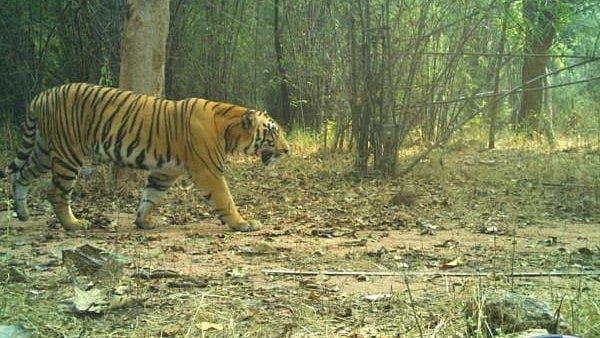
A view of tiger at Kawal Tiger Reserve (KTR) in erstwhile Adilabad district in Telangana
Credit: DH Photo
Hyderabad: Efforts are on to relocate three more villages from the core area of Kawal Tiger Reserve (KTR) in erstwhile Adilabad district in Telangana Under 'Project Tiger.
Under 'Project Tiger,' human settlements are voluntarily relocated to make the core area inviolate and foster a viable tiger population.
The National Tiger Conservation Authority (NTCA) found that there are 10 to 12 villages inside the core area of KTR that have huge disturbances that need to be relocated.
“There are 10-12 villages inside the core area that have huge disturbances that need to be relocated. This is a herculean task. Relocating the villages could solve the meadow and fodder issues, while also making the area inviolate,” according to a note from NTCA.
Two villages, home to 94 families, have already been relocated to a newly established rehabilitation colony spanning approximately 13 acres.
Currently, efforts are underway to relocate an additional three villages. Kawal Tiger Reserve is located in the northeastern part of Telangana in the Old Adilabad district, having the Godavari River on one side and the Maharashtra border on the other side. The Government of India declared Kawal Wildlife Sanctuary a Tiger Reserve in 2012. The total area of KTR is 15.44 sq. km, of which the core area is 893 sq. km. KTR extends in the districts of Nirmal, Mancherial, Adilabad, and KB Asifabad Districts.
In the last few months, two villages, Maisampet and Rampur, were relocated to Kothpadepally in Kadam mandal, where a rehabilitation colony with all the facilities has come up. The relocated families received financial assistance, residential sites, and agricultural land from the government.
Authorities have now identified Alinagar, Dongapalli, and Mallial for relocation, with the villagers said to have expressed their readiness to do so.
State Minister for Forests, Environment, and Endowments, Konda Surekha, recently announced in the Legislative Council that Kawal Tiger Reserve has been designated as a Conservation Reserve Forest. She also elaborated on the steps taken to address issues affecting local wildlife and forest-dependent communities.
“To support the families being relocated, the government is providing them with essential facilities such as housing, water supply, and livelihood assistance. Awareness programs are also being conducted to educate the affected communities about the benefits of relocation. The aim is to facilitate voluntary relocation by offering substantial welfare and economic support. The government is working to develop Kawal Tiger Reserve to match the standards of the Amrabad Tiger Reserve. These efforts reflect the state’s commitment to protecting wildlife while prioritising the well-being of forest-dependent communities. The relocation process is being handled smoothly with the involvement of forest officials and continued engagement with the local population,” said Surekha.
Geographically, the reserve is located in the southernmost tip of the Central Indian Tiger Landscape, sharing connections with the Tadoba-Andhari (Maharashtra) and Indravati (Chhattisgarh) tiger reserves. Thus, the habitat has tremendous significance for tiger conservation in the region. It is also a major catchment of the Godavari River and local rivulets like Peddavagu and Kadam.
NTCA found that sand mining, poaching, destruction of teak forests, migratory cattle, vehicular disturbance, and lack of water and fodder were major threats in the reserve. Given the scarcity of sand in nearby villages/towns, sand mining emerged as the primary issue.
Political leaders, staff, and villages played a significant role in controlling the situation to some extent, but the threat remains constant. The presence of teak and bamboo is a constant threat for habitat destruction due to felling and smuggling. The establishment of base camps in the interior forest areas, along with the deployment of strike forces and anti poaching squads, has effectively controlled the threats.
“All vehicular traffic is prohibited from 9 pm to 6 am on the roads passing through the tiger reserve. Heavy vehicles of certain categories are prohibited at all times on the roads passing through Kawal Tiger Reserve. Fire is another managerial issue to be tackled as the entire area is fire prone and burns almost twice in the season,” said NTCA.